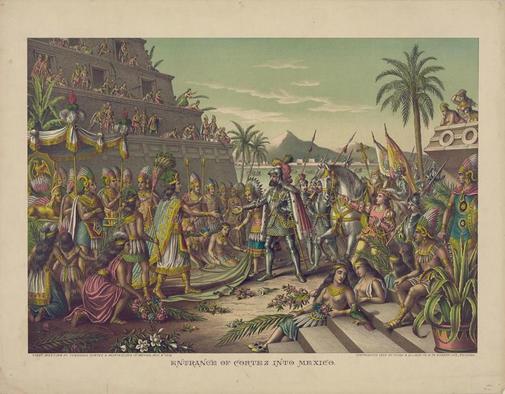- Profile: Hero, writer and entrepreneur: Hernán Cortés against his black legend
On August 16, 1519, 500 years ago, Hernán Cortés de Monroy and Pizarro Altamirano left Villa Rica de la Vera Cruz (now Veracruz), an enclave he had founded in April, to march towards Tenochtitlán, capital of the Aztec-Mexican empire .
Cortes responded to an invitation, through various emissaries, from Emperor Moctezuma, eager to meet who he took for Quetzalcoatl. A white and bearded god who, according to myth, had abandoned the Aztecs at a remote time after promising them that, one day, he would return from the east.
Cortes was 34 years old and had been in those continental lands for six months after arriving in the Indies, in search of glory and fortune, in 1504. He had first arrived in Hispaniola (Santo Domingo). From there he had left, in 1511, for Cuba as secretary of Diego Velázquez de Cuéllar , appointed governor of the island, who, in turn, appointed him mayor of the newly founded Santiago.
Until 1518, Cortés enjoyed and suffered all kinds of vicissitudes, including prisons, in his stormy relationship with Velázquez. He felt stiff and wanted to jump to the mainland. The governor ended up giving in. He instructed Cortes to explore the Yucatan Peninsula under the express prohibition of permanently founding a colony. Without the slightest intention of obeying him (see Veracruz), Cortés set sail for Yucatán on February 10, 1519 on 11 ships with about 900 men (including about 200 Indians and blacks), about twenty horses, 10 guns and a diminished supply of arcabuces and minor weapons.
On March 12, in Tabasco, he had the first confrontations with the natives . Disregarding the orders of the repentant and increasingly furious Velázquez, he continued his campaign of discoveries and conquests. Throughout the following months, supported by the mixture of terror and fascination that the horses, artillery, armor, etc., caused to the natives, incorporated them into the crown of Spain through violence or persuasion . By force of arms or words.
The march of Cortes towards Tenochtitlan that August 16, 1519 marks a before and after in the history of the conquest of Mexico. Again, killing enemies or uniting them to their cause , which did not cease to benefit Moctezuma himself, also faced with them in tribal struggles, Cortes arrived at Tenochtitlan on November 8.
The first and idyllic months of the Spanish entertained twisted because of religious clashes and the excited greed of foreigners. Cortés, moreover, had always thought of taking over the Aztec Empire. Thus, ignoring the governor once more, he had informed Carlos I by sending a ship to Spain, burning or rendering the rest useless to avoid defections or messages to Velázquez. The hostilities unleashed, Cortés took the indigenous leader, who was subjected to him.
The events rushed. In April 1520, Cortés learned that Velázquez had sent a contingent commanded by Pánfilo de Narváez to arrest him. He went out to meet Narvaez and defeated him. Many of the expeditionaries called to fight him joined him by conviction or ambition. Meanwhile, suspiciously, suspicious of an imminent revolt, Pedro de Alvarado, whom Cortes had left in command in Tenochtitlan, had cut by the sound based on steel and lead. The bloody fight became widespread .
Cortés returned to the city and asked an overflowing Moctezuma to calm his subjects. While doing so, the emperor received a stone that killed him. The Mexica named his brother Cuitláhuac successor, nothing inclined to coexistence. Cortes and his fled and many of them were massacred in the early hours of June 30 to July 1, 1520, in the so-called Sad Night.
Cortes counterattacked on July 7. For more than a year, in different episodes of confrontations, retreats and processes of preparation and enlistment, the conquest of Tenochtitlan presided over the performance of the Spaniards in New Spain. On August 13, 1521, Cuauhtémoc, who had succeeded Cuitláhuac, died of smallpox, was taken prisoner and the city capitulated .
From that day until December 2, 1547, the day of his death in Castilleja de la Cuesta (Seville), Cortes' career will be, like that of so many conquerors: an alternative succession of military triumphs and political defeats with Carlos I disallowing him to stockings and, also half, claiming it. A messy chain of honors and falls in disgrace; round trip ... We were going to write that this is another story. But no. It's the same. The same and repeated. Eternal.
Cortes - let's go back - had said goodbye to the great feats with the discovery, in 1536, of the Baja California Peninsula. In 1540 he had returned to Spain to settle and try, in vain, to recover the royal favor. Today his also bumpy remains rest, as he expressed in his last will, in the church of the Hospital de Jesús Nazareno, in Mexico City .
According to the criteria of The Trust Project
Know more- Mexico
- history
- culture
The Paper Sphere Tom Treanor, the best World War II reporter
PoetryArthur Rimbaud receives letters 127 years after his death
History Churchill, Hitler, Franco and the actor of 'What the wind took away' that could change World War II

